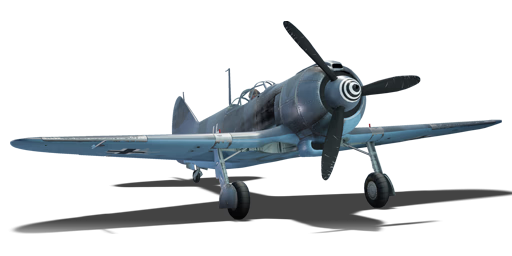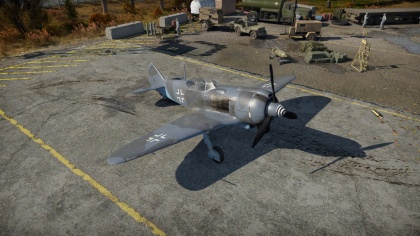La-5FN (Germany)
Contents
| This page is about the premium German fighter La-5FN (Germany). For the Russian version, see La-5FN. For other uses, see La-5 (Family). |
Description
The ▀La-5FN is a rank III premium German fighter
with a battle rating of 4.0 (AB/SB) and 3.7 (RB).
General info
Flight Performance
| Characteristics | |||||||
|---|---|---|---|---|---|---|---|
| Stock | |||||||
| Max Speed (km/h at 6,100 m) |
Max altitude (meters) |
Turn time (seconds) |
Rate of climb (meters/second) |
Take-off run (meters) | |||
| AB | RB | AB | RB | AB | RB | ||
| 595 | 576 | 11350 | 20.0 | 20.8 | 17.6 | 17.6 | 341 |
| Upgraded | |||||||
| Max Speed (km/h at 6,100 m) |
Max altitude (meters) | Turn time (seconds) | Rate of climb (meters/second) |
Take-off run (meters) | |||
| AB | RB | AB | RB | AB | RB | ||
| 648 | 620 | 11350 | 18.0 | 19.0 | 27.6 | 22.0 | 341 |
Details
| Features | ||||
|---|---|---|---|---|
| Combat flap | Take-off flap | Landing flap | Air brakes | Arrestor gear |
| X | X | X | X | X |
| Limits | ||||
|---|---|---|---|---|
| Wing-break speed (km/h) |
Gear limit (km/h) |
Combat flap (km/h) |
Max Static G | |
| + | - | |||
| 0 | 310 | ??? | ~?? | ~? |
| Optimal velocities | |||
|---|---|---|---|
| Ailerons (km/h) |
Rudder (km/h) |
Elevators (km/h) |
Radiator (km/h) |
| < ??? | < ??? | < ??? | > ??? |
| Compressor (RB/SB) | ||
|---|---|---|
| Setting 1 | ||
| Optimal altitude | 100% Engine power | WEP Engine power |
| ?,??? m | ??? hp | ?,??? hp |
Survivability and armour
- No armour plating
- No armour glazing
- Critical components located at front of aircraft (fuel, pilot, engine, controls)
- More fuel tanks located in wings near fuselage
Armaments
Offensive armament
Main article: Bombs-->
Usage in the battles
Manual Engine Control
| MEC elements | ||||||
|---|---|---|---|---|---|---|
| Mixer | Pitch | Radiator | Supercharger | Turbocharger | ||
| Oil | Water | Type | ||||
| Controllable | Not controllable | Not controllable | Not controllable | Separate | Not ontrollable | Not controllable |
Modules
| Tier | Flight performance | Survivability | Weaponry | ||
|---|---|---|---|---|---|
| I | Fuselage Repair | Radiator | |||
| II | Compressor | Airframe | |||
| III | Wings Repair | Engine | |||
| IV | Engine Injection | Cover | |||
Pros and cons
Pros:
Cons:
History
In early 1942, Semyon Lavochkin's LaGG-3 fighter was under threat of having its production cancelled, having proved itself to be a flawed fighter, underpowered and overweight. At the same time, Arkady Shvetsov faced a lack of demand for his M-82 radial engine, only successfully used by the Sukhoi Su-2 ground attack aircraft that was also in danger of being cancelled. The two designers met at a conference in Moscow, and Shvetsov agreed to help Lavochkin fit the M-82 engine to the LaGG-3 airframe. Mikhail Gudkov, one of the original designers of the LaGG-3, had already attempted to do the same thing, resulting in the Gu-82 fighter. However, he had delayed too long in getting the fighter into production, and by April 1942, Aleksander Yakovlev had succeeded in getting production of the LaGG-3 cancelled in favour of his Yak-7 fighter, effectively monopolising Soviet fighter production.
Lavochkin's OKB was, in the meantime, transfer to the backwaters of Tbilisi, Georgia and he and his team had to work almost illegally and in harsh conditions to modify the LaGG-3 for the M-82 engine. The radial engine was physically wider than the LaGG-3 fuselage cross-section, requiring skirting to attach the larger engine and to the fuselage, and the M-82 also had no space for an engine-mounted cannon, unlike the Klimov M-105. Thus, the updated armament changed to two 20 mm ShVAK cannon mounted on top of the engine. The new LaGG-3 M-82 (also known as the Samolyot 37 (Aircraft 37) or the Type 37) was completed in February 1942 and underwent test flights, with promising results despite problems with engine cooling. Its performance was better than any Soviet fighter then in service. Other issues revealed in testing consisted of excessive control forces, oil leaks, and excessive weight, but these could not overshadow the LaGG-3 M-82's excellent performance, and its full-scale development began as the LaG-5. The first fully operational LaG-5s was delivered on 20 June 1942.
Series LaG-5s suffered from poor quality, which reduced performance considerably. As was revealed in the test flights, pilots found it to be a more difficult aircraft to fly than the Yak-1 or LaGG-3, but the radial engine enhanced protection during head-on attacks. Redesignated La-5 in September 1942, the new fighter faced its first important test during the battle of Stalingrad. It proved not to be enough to equal the Bf 109 F-4 and G-2 models but was considered capable of further improvement. Continuous improvements to the La-5 would eventually lead to the La-5F, La-5FN, and finally the La-7, among some of the most excellent Soviet fighters of the Great Patriotic War.
In-game description
"The Lavochkin La-5 was a single-engine monoplane fighter, a single-seater with an enclosed cockpit, wooden frame and a canvas skin. FN in the designation stands for Boosted, Fuel Injection. The new variant entered production and began to reach front-line units in March 1943. The La-5FN, rather than being a successor to the earlier La-5F, was produced concurrently. Its ASh-82FN engine could reach 1,850 HP and remain at takeoff power settings for up to 10 minutes.
In April 1943 a serial La-5FN was flight tested in mock combat against a captured Bf-109G-2. The Soviet aircraft proved superior at low and medium altitudes, the most common on the Eastern Front. The La-5FN was superior both in top speed as well as maneuvering in the vertical. An analysis of these engagements led to significant changes in Soviet tactics. The La-5FN's armament was identical to that of the La-5 and consisted of twin 20mm ShVAK cannon with 200 rounds per gun. The guns were pneumatically or mechanically operated."
Media
An excellent addition to the article will be video guides, as well as screenshots from the game and photos.
Read also
Links to the articles on the War Thunder Wiki that you think will be useful for the reader, for example,
- reference to the series of the aircraft;
- links to approximate analogues of other nations and research trees.
Sources
Paste links to sources and external resources, such as:
- topic on the official game forum;
- page on aircraft encyclopedia;
- other literature.
| Lavochkin Design Bureau (Лавочкинa Опытное конструкторское бюро) | |
|---|---|
| LaGG-3* | I-301 · LaGG-3-4 · LaGG-3-8 · LaGG-3-11 · LaGG-3-23 · LaGG-3-34 · LaGG-3-35 · LaGG-3-66 |
| La-5/7 | La-5 · La-5F · La-5FN · La-7 · Dolgushin's La-7 · La-7B-20 |
| La-9/11 | La-9 · La-11 |
| Jet Fighters | La-15 · La-174 · La-200 |
| Export | ␗La-9 · ␗La-11 |
| Captured | ▀La-5FN |
| *Lavochkin-Gorbunov-Gudkov (Лавочкин-Горбунов-Гудков), head designer V. P. Gorbunov | |
| Germany fighters | |
|---|---|
| Heinkel | |
| He 51 | He 51 A-1 · He 51 B-1 · He 51 B-2/H · He 51 C-1 · He 51 C-1/L |
| He 100 | He 100 D-1 |
| He 112 | He 112 A-0 · He 112 B-0 · He 112 B-1/U2 · He 112 B-2/U2 · He 112 V-5 |
| Messerschmitt | |
| Bf 109 (Jumo) | Flegel's Bf 109 A · Bf 109 B-1 · Bf 109 C-1 · Bf 109 C-1 |
| Bf 109 (DB-601) | Bf 109 E-1 · Bf 109 E-3 · Bf 109 E-4 · Bf 109 E-7/U2 · Bf 109 F-1 · Bf 109 F-2 · Bf 109 F-4 · Bf 109 F-4/trop |
| Bf 109 (DB-605) | Bf 109 G-2/trop · Bf 109 G-2 · Bf 109 G-6 · Bf 109 G-10 · Bf 109 G-14 · Bf 109 K-4 |
| Focke-Wulf | |
| Fw 190 (early) | Fw 190 A-1 · Fw 190 A-4 · Fw 190 A-5 · Fw 190 A-5 · Fw 190 A-5/U2 · Fw 190 A-5/U14 · Fw 190 A-8 · Fw 190 C |
| Fw 190 (late) | Fw 190 D-9 · Fw 190 D-12 · Fw 190 D-13 |
| Ta 152 | Ta 152 C-3 · Ta 152 H-1 |
| Blohm & Voss | |
| BV 155 | BV 155 B-1 |
| Captured: | |
| USA | ▀P-47D-16-RE · ▀P-47D |
| USSR | ▀La-5FN · ▀Yak-1B |
| Britain | ▀Tempest Mk V |
| Italy | |
| CR.42 | ▀CR.42 · ▀Marcolin's C.R.42 CN |
| G.50 | ▀G.50 serie 2 · ▀G.50 AS serie 7 |
| C.200 | ▀C. 200 serie 3 · ▀C. 200 serie 7 |
| C.202 | ▀C. 202 |
| Finland | ▀Hawk H-75A-2 |





